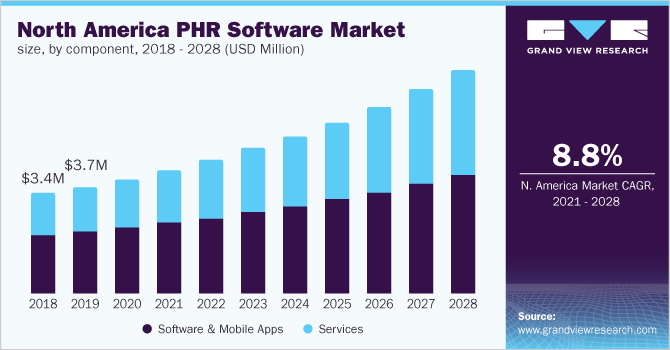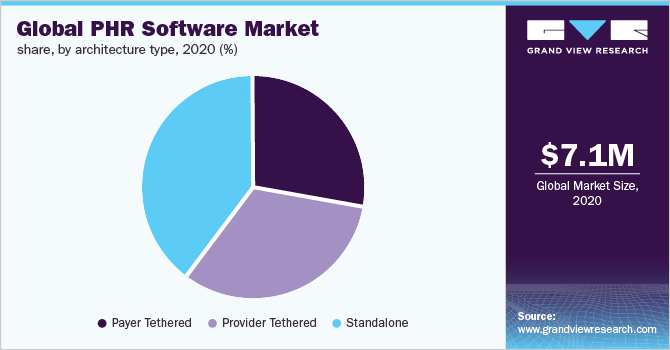- Home
- »
- Healthcare IT
- »
-
Personal Health Record Software Market Report, 2028GVR Report cover
![Personal Health Record Software Market Size, Share & Trends Report]()
Personal Health Record Software Market Size, Share & Trends Analysis Report By Component (Software & Mobile Apps, Services), By Deployment Mode (Cloud-, Web-based), By Architecture Type, And Segment Forecasts, 2021 - 2028
- Report ID: GVR-4-68039-525-9
- Number of Report Pages: 150
- Format: PDF, Horizon Databook
- Historical Range: 2016 - 2019
- Forecast Period: 2021 - 2028
- Industry: Healthcare
Report Overview
The global personal health record software market size was valued at USD 7.07 million in 2020 and is expected to grow at a compound annual growth rate (CAGR) of 9.9% over the forecast period. Factors such as growing demand for centralizing & streamlining healthcare information, increasing demand for cloud-based software for dealing with individual data, and rising initiatives to promote patient-centric care will drive the market during the forecast period. For instance, in March 2018, Apple introduced Personal Health Record (PHR) program after two months of a pilot project to enhance patient engagement. The COVID-19 pandemic has toppled the way of work and life, generating an immediate requirement for digital tools as businesses across all sectors and regions augmented their digital revolution efforts and moved their products & services online.

In earlier days, numerous patient records were controlled by healthcare groups and, usually, the records lived in siloes that prevented healthcare practitioners from sharing health information. Thus, the pandemic has enforced healthcare groups to share individual’s medical records in a set-up that is meaningful and effortlessly accessible. For instance, the Department of Health and Human Services Office of the National Coordinator for Health Information Technology, accompanied by the Centers for Medicare & Medicaid Services, issued two new rules to come into force in April 2021.
These rules are intended to advance the ability of individuals to access their health data. One rule needs healthcare groups to make health record data available electronically through broadly used technical standards. The other forbids “information blocking,” where healthcare groups place excessive practical, cost, and technical barriers to the sharing of health information. Overall, the COVID-19 pandemic positively affected the market growth. The market growth is attributed to the high acceptance of advanced technologies to cater to rising customer needs.
Moreover, rising awareness among urban patients about medical information storage and management, and increasing government initiatives to encourage paperless data integration in the healthcare sector are expected to support the market growth. For example, in August 2020, the government of India announced the introduction of the National Digital Health Mission. However, concerns over individual health data security are forming barriers. This, in turn, is affecting patient engagement initiatives and limiting the adoption of PHR solutions among end-users.
PHR Software Market: Steady growth of over 8.0% experienced during the COVID-19 pandemic
Pandemic Impact
Post COVID Outlook
In 2020, the market registered a YoY growth rate of 8.3%, which was as expected
The YoY growth from 2020 to 2021, is expected to be 8.4%.
The pandemic enforced healthcare groups to share individual’s medical records in a set-up that is meaningful and effortlessly accessible
Supportive government regulations focused on public health will help the market growth
The Department of Health and Human Services Office of the National Coordinator for Health Information Technology, accompanied by the Centers for Medicare & Medicaid Services, issued two new rules to come into force in April 2021
Personal health records simplify the procedure of sharing appropriate health information with healthcare providers, which aids the patient to facilitate care coordination and advance chronic disease management. The growing prevalence of chronic diseases, such as COPD, asthma, diabetes, cancer, and stroke, is expected to fuel the adoption of PHRs. Thus, efficient delivery of care and improved patient-provider relationships further contribute to overall market growth.
Component Insights
The software & mobile apps segment dominated the market with a revenue share of over 57% in 2020. Rising technological developments in the healthcare industry support the segment growth. The demand for health record applications that need a smart and easy-to-practice user interface and high-speed internet connection for quick accessibility is increasing. Thus, increasing usage of smartphones and high-speed networks is anticipated to fuel the segment growth during the forecast period.
The services segment is expected to register the fastest CAGR over the forecast period. Earlier, a patient’s PHRs classically were paper documents saved on file. Businesses, such as PicnicHealth, are offering PHR services. In September 2020, PicnicHealth raised $25 million for its patient health record management service.
Deployment Mode Insights
The web-based deployment mode segment dominated the personal health record software market with a revenue share of 52.0% in 2020. The rising adoption of online apps and development in digitization is likely to drive the segment during the forecast period. Progress of the up-to-date and innovative technologies allows users to access apps with the aid of Uniform Resource Locators (URLs). In addition, advantages associated with web-based PHR software, such as easy exchange of vital details between patients and multiple clinicians, further contribute to segment growth.
The cloud-based segment is expected to register the fastest CAGR over the forecast period. Increasing demand for mobility in data usage cost-saving in IT infrastructure for enterprises, and multiple device access from anywhere promotes the segment growth. In e-health, the security and privacy of health data are one of the major concerns. Cloud server provider usually is a third-party module; thus, health data should be strongly stored to guard privacy. Cloud servers are semi-trusted because they will not actively try to get the information warehoused.
Architecture Type Insights
The standalone segment led the global personal health record market in 2020 with a revenue share of over 40%. The segment will expand further at the fastest CAGR from 2021 to 2028. The system is completely patient-controlled, and providers can only view the data when their patients offer them access. Benefits of using a standalone PHR, such as perceived privacy control and belief, are the main factors boosting the segment growth. In addition, patient data management is the main distinctive factor associated with standalone PHRs; this is also expected to support segment growth.

The provider-tethered segment is expected to grow at a steady CAGR of more than 9.5% from 2021 to 2028. Provider-tethered PHRs are secured to a healthcare administration’s internal record system. Government initiatives to encourage healthcare IT usage and the introduction of technologically advanced healthcare services are expected to drive the segment growth.
Regional Insights
North America dominated the market and accounted for a revenue share of over 55% in 2020. The major factor contributing to its growth are government initiatives for eHealth, and the increased need to follow regulatory guidelines & curtail the escalating healthcare costs. In addition, the strong focus of non-government organizations on the development of a highly sustainable healthcare system in the region will accelerate the market growth during the forecast period.
The rest of the world is expected to show the fastest growth rate over the forecast period. The rising demand for remote patient monitoring solutions, due to the aging populace and growing cases of long-term chronic conditions, is the main factor driving the growth of the market.
Key Companies & Market Share Insights
The market players are involved in new product launches and business expansions to sustain the competition. Competitors are also implementing other business growth strategies to strengthen their market position. For instance, in March 2020, Knapsack Health launched a free PHR software for individuals, families, and caretakers. In February 2019, Fujitsu proclaimed Fujitsu Healthcare Solution Healthcare Personal Service Platform. This new Platform-as-a-Service (PaaS) can aggregate and integrate an individual’s PHR. Some of the prominent players in the global personal health record software market include:
-
Healthspek
-
Health Companion
-
NoMoreClipboard
-
Patient Ally
-
Records For Living, Inc.
-
Practice Fusion, Inc.
-
SoftClinic Software
-
Knapsack Health
-
75Health (Kaaspro)
-
Zapbuild
-
Validic
Personal Health Record Software Market Report Scope
Report Attribute
Details
Market size value in 2021
USD 7.69 million
Revenue forecast in 2028
USD 14.87 million
Growth rate
CAGR of 9.9% from 2021 to 2028
Base year for estimation
2020
Historical data
2016 - 2019
Forecast period
2021 - 2028
Quantitative units
Revenue in USD million and CAGR from 2021 to 2028
Report coverage
Revenue forecast, company ranking, competitive landscape, growth factors, and trends
Segments covered
Component, deployment mode, architecture type, and region
Regional scope
North America; Europe; Rest of the World
Country scope
U.S.; Canada; Germany; U.K.; France
Key companies profiled
Healthspek; Health Companion; NoMoreClipboard; Patient Ally; Records For Living, Inc.; Practice; Fusion, Inc.; SoftClinic Software; Knapsack Health, 75Health (Kaaspro); Zapbuild; Validic
Customization scope
Free report customization (equivalent up to 8 analysts working days) with purchase. Addition or alteration to country, regional & segment scope.
Pricing and purchase options
Avail customized purchase options to meet your exact research needs. Explore purchase options
Segments Covered in the Report
This report forecasts revenue growth at global, regional, and country levels and provides an analysis of the latest industry trends in each of the sub-segments from 2016 to 2028. For the purpose of this study, Grand View Research has segmented the global personal health record software market report on the basis of component, deployment mode, architecture type, and region:
-
Component Outlook (Revenue, USD Million, 2016 - 2028)
-
Software & Mobile Apps
-
Services
-
-
Deployment Mode Outlook (Revenue, USD Million, 2016 - 2028)
-
Web-based
-
Cloud-based
-
-
Architecture Type Outlook (Revenue, USD Million, 2016 - 2028)
-
Payer Tethered
-
Provider Tethered
-
Standalone
-
-
Regional Outlook (Revenue, USD Million, 2016 - 2028)
-
North America
-
U.S.
-
Canada
-
-
Europe
-
U.K.
-
Germany
-
France
-
-
Rest of the World
-
Frequently Asked Questions About This Report
b. The global personal health record software market size was estimated at USD 7.07 million in 2020 and is expected to reach USD 7.69 million in 2021.
b. The global PHR software market is expected to grow at a compound annual growth rate of 9.9% from 2021 to 2028 to reach USD 14.87 million by 2028.
b. North America dominated the personal health record software market with a share of 55.9% in 2020. This is attributable to government initiatives for eHealth, the rising need to follow regulatory guidelines, and the rising need to curtail the escalating healthcare costs.
b. Some key players operating in the personal health record software market include Healthspek; Health Companion; NoMoreClipboard; Patient Ally; Records For Living, Inc.; Practice; Fusion, Inc.; SoftClinic Software; Knapsack Health, 75Health (Kaaspro); Zapbuild; and Validic.
b. Key factors that are driving the personal health record market growth include growing demand for centralizing & streamlining of healthcare information, increasing demand for cloud-based software for dealing with individual data, and rising initiatives to promote patient-centric care.
Share this report with your colleague or friend.
![gvr icn]()
NEED A CUSTOM REPORT?
We can customize every report - free of charge - including purchasing stand-alone sections or country-level reports, as well as offer affordable discounts for start-ups & universities. Contact us now
![Certified Icon]()
We are GDPR and CCPA compliant! Your transaction & personal information is safe and secure. For more details, please read our privacy policy.
We are committed towards customer satisfaction, and quality service.
"The quality of research they have done for us has been excellent."





